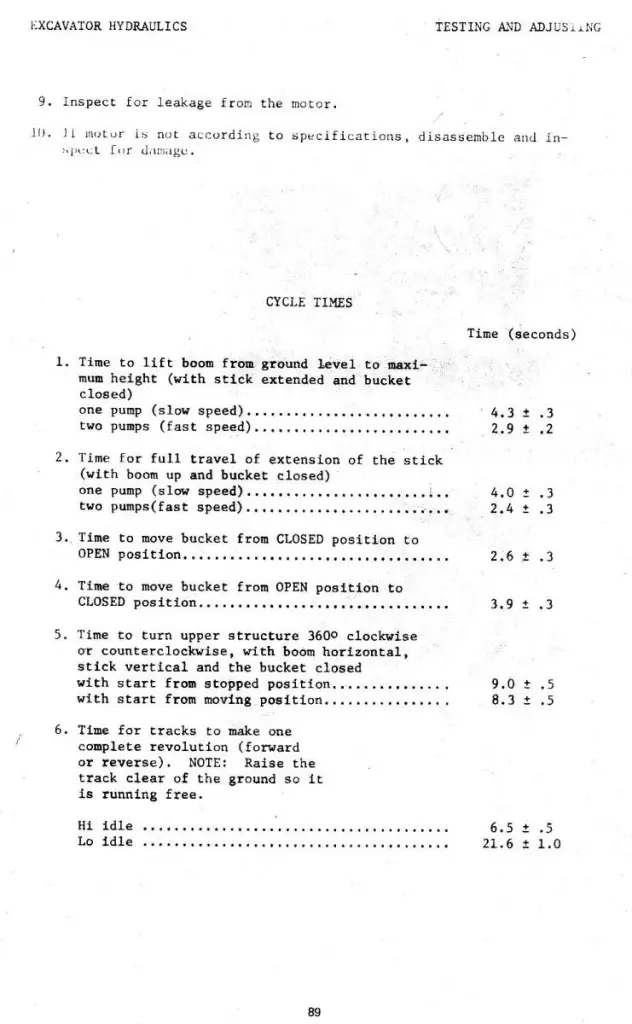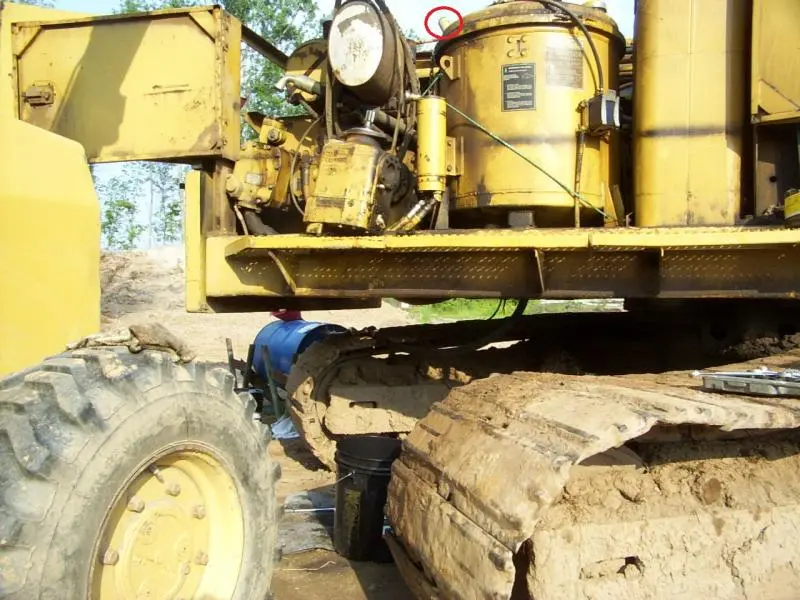The 1145/1150/1160/3145/3150/3160/3208 blocks are all the same basic dimensions so that can't be the problem, in fact, most are interchangeable. Anyone changing would, I hope, have the sense to change the flywheel housing and coupling if necessary? Can you get any numbers off the housing to compare just in case a different housing and coupling has been fitted. Someone has had overheat problems before with this machine, that's why the hood is raised, the most common fault is trash between the radiator and hydraulic cooler, most seem to think it too much trouble to wash out between the two. I can't see Cat moving the engine and pumps to fit high ambient cooling when there is plenty of room around the radiator area to move it forward.
The raised hood can allow air recirculation making things worse.
If the engine dies on main boom raise, it could be that the pumps have been screwed up too much but I would not even look at this on a 3208 engine before getting a mechanical fuel pressure gauge on and checking fuel pressure under full load/hyd stall.
[quote]Someone has had overheat problems before with this machine[/quote]
When I bought the machine, the I asked the mechanic who did the 3208 R&R why the hood was raised. He said after he replaced the 3208, it was overheating, and his boss told him to raise the hood. It worked, so they ran it like that for a couple thousand hours...
I did try to lower the hood down into the normal position, and sure enough the unit overheated.
[quote]If the engine dies on main boom raise...[/quote]
That's the thing, the engine does not lug. I've dug 3 ponds with this machine and cleared 10 acres of land, the only issue I have had with it is when the oil gets hot, the boom up is very slow when I have a full bucket of wet clay. And I mean slow, the boom takes like 10-15 seconds to raise from down in the hole to dumping the load into the truck (with the boom crossover pedal depressed), it's faster when I have a bucket full of sandy loam etc. This machine does have an oversized bucket.
What I really want to nail down at the moment is why the custom rear motor mounts are required. I will try to get some numbers off the bell housing if someone can clue me in on where they would be located?
If the boom raise is slow, the engine does not lug and the hydraulics run hot, I would be looking for a relief valve pressure problem or possibly pump leakage to build up the heat while not producing the movement. It definitely needs some pressure checks before going too far in pulling bits off it to take a look.
I do plan to do such testing this spring, but while the weather is crappy, I figured I'd start researching the issue with the pump drive being moved due to the 3208 replacement.
I have never measured the temp of the oil, and now I don't recall if there is a gage for that in the cab...
It just seems like the root of the issue is this 3208 replacement, that looks like it was a bit of a hack job. Could it be that raising the hood means the HYD oil is getting too hot and this is slowing down the implements due to the oil being too thin and passing seals etc?
EDIT: I have found the S/N of the original engine that came from the factory with this 225, it is written in the parts manual. S/N T9V4699 (I think the T is supposed to be a 7?) However, I have still not found a S/N plate on the current 3208 that is in the machine.
at operating temperature....do you have pressure in the hydraulic tank?
Well, what I can tell you is I have never been able fill the oil halfway up the sight glass (with the boom, stick and bucket in the correct locations), because when the oil gets up to temp, a bunch of it (maybe 2-3 gallons) overflows out of the tank, it's been like that since I bought the machine in 2006. I have never seen the hydraulic oil temp gage get into the red. I suppose I should actually measure the oil temp when running it this summer...

Hi Team,
seem to recall that early Naturally Aspirated engine units had a pump to pressurise the hydraulic tanks--it was known to fail as most people were not aware of it's existence.
There should be a pressure relief valve cum filter on the tank, check it is operational and that it holds pressure in the tank--I do not have a Parts Book and can find nothing on the tank and valve etc. in my Cat School Book so cannot help further. The School book is only selected parts of a Serv. Manual.
If the tank is not pressurised then when 2 pump flow is called for, oil flow from the tank will be restricted and the oil will likely aerate due to pump cavitation. A low set Pressure Relief Valve can aerate oil too.
Aerated oil does not cool well either and will likely discharge from the unpressurised tank breather/relief valve.
A properly sealed tank, without an air pump etc. will naturally pressurise as the system heats up as long as the tank relief does seal properly. Other system oil leaks can reduce this tank pressure too.
I believe this system needs to be pressurised by an outside source to work properly--I stand to be corrected.
Later with the turbo engine powered machines they have a check valve, to keep the boost in the tank, and a line going from the engine inlet manifold to put boost pressure into the tanks.
Maybe check this simple thing first to address the tank overflow.
Your engine overheat may be addressed when you fit the larger fan.
As long as the engine is sound and the engine High Idle RPM's and Rack Settings for Horsepower and Full Load 2200+-15 Rpm's are correct for a 225 then it should not overheat--famous last words.
You say the engine is not lugging when loaded so we await the results of the correct fan being fitted.
Within reason I do not see the hacked engine swap being the problem as long as the correct fan and shroud/cowling is fitted and if I recall correctly, at least 2/3 of the fan blade edge is aligned to the shroud. The fan blade should not be fully inside or outside the shroud or it will not produce correct suction in the space between the shroud and core.
There should be minimum gaps between the shroud tin work and the radiator frame so as maximum air is pulled thru the core--I think I gave air flow figures for the 225 previously, the air flow test is done at Low Idle and for the 225 that would be ---???? I do not have Rack Settings for these later machines.
Cheers,
Eddie B.

Wow, a lot of good info there Eddie, thank you. I have full set of CAT service manuals and parts book for this machine, so I'll start researching this tank valve.
Ok, well I found 3 valves in my parts book that deal with the tank pressure (I think).
9J2084 "Drain Valve Group" which mounts on top of the 9J3952 "External Filter Group"
9J2041 "Cooler Relief Valve Group"
8J3738 "Valve" is mounted right on top of the tank.
I guess I am a bit confused when you say the non-turbo 225's had a "pump" to pressurize the HYD tank, are we saying an air pump that is run off a belt on the engine?
I will add that I have never seen "foamy" oil on this machine.
In the attached picture, I assume what I have circled is the "HYD Tank Pressure Relief Valve".
[attachment=33901]CAT-225-Tank.jpg[/attachment]
Hi,
looks like the pressure relief valve/filter you have circled, from memory, should be dismantle-able for cleaning--maybe-- too long ago now.
Early machines used the small Cat V8, they were not turbo charged. I believe this model had the battery powered electric motor driven vane type air pumps.
This was mounted on the non engine side of the firewall if I recall. They gave a lot of trouble, cannot recall any other details as to cut in, cut out control--if any, etc.
Later 225's, from memory, used Turbo charged D330 engines--these used the turbo boost pressure to keep the tanks charged--they had a one way check valve to stop the tank pressure and oil discharging back into the engine inlet manifold. I could be wrong--not the first time-- on the engine upgrade.
Are just trying to help as there seems to be no one else with more hands on to the little I have done a very long time ago back in the 1970-80's, this is why I am a bit unsure without looking at some iron.
It is good to hear you have not seen any foamed oil in the tank.
Cheers,
Eddie B.